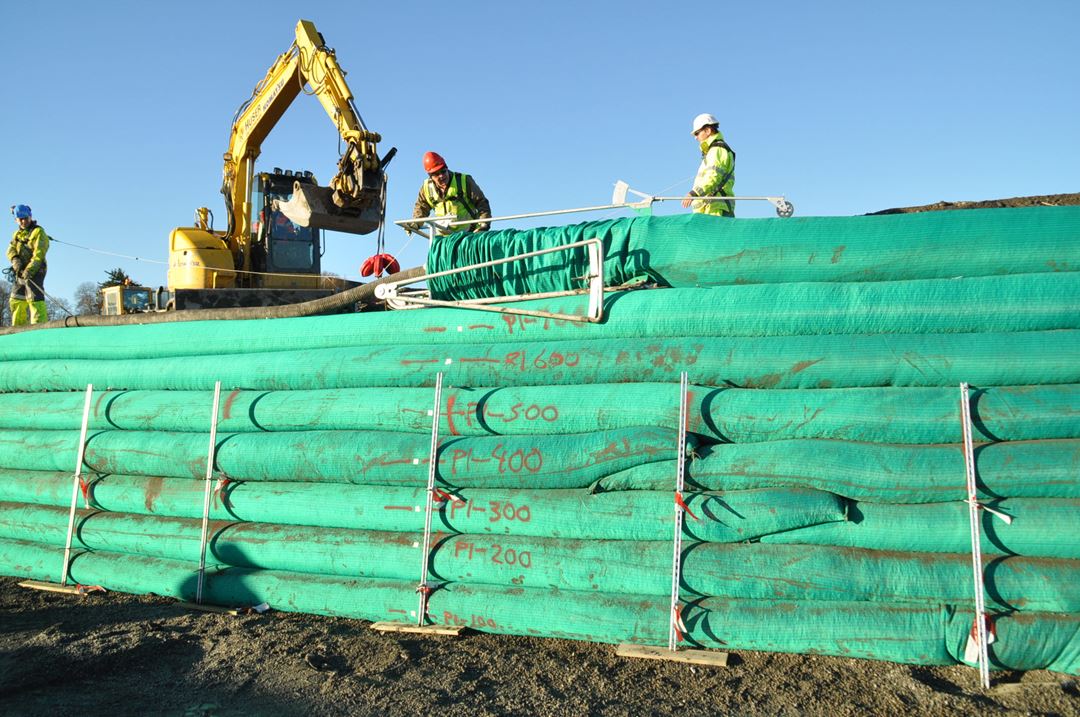Building and renovation in steep, difficult terrain can be challenging. Urban areas where accessibility with construction vehicles is difficult pose similar problems.
These days, the prevalence of landslides, shifting sediments and unstable substrates is drawing increasing attention to these problems. Closed roads and railways and the evacuation of residential areas which have to be rehabilitated and rebuilt are expensive for society, and this has prompted researchers to think innovatively.
“We have developed a solution in which material is simply blown into place, making it possible to get to places where space is limited, there is no access for construction machinery and existing roads or railway lines have collapsed, to mention just some of the problems,” says Arnstein Watn, SINTEF’s Research Director.
Advanced “geomaterials” make it possible
Geotextiles are woven or knitted fabrics or nets based on polymers, which can be used to reinforce sedimentary masses. They are stacked up to create a light wall – a kind of shuttering. The wall is then bonded firmly to the uncompacted material behind using hooks and an anchoring system which is also made from geotextiles. This solution saves both time and space because it does not require an access road for heavy construction machinery.
(Insert an illustration here showing this.)
Read more: http://gemini.no/2006/11/vever-nytt-landskap-pa-svalbard/ Weaving a new landscape in Svalbard (Article in Norwegian)
The result is a light, stable wall capable of withstanding slopes of up to 90 degrees, and which can also be concealed by various facings, such as turf, climbing plants or various types of façade sheets as required.
When the wall is in place, the space behind is filled with light expanded clay aggregate, either using conventional construction machinery or by blowing it in.
“What makes the method unique is that it facilitates drainage and the result is light and stable as well as being easy to put in place,” says Watn.
Already tested in the field
SINTEF has been responsible for developing the technical solution and the construction method used. So far the method has been tested at two localities. At Saint-Gobain Weber’s factory property in Fredrikstad, an embankment was first built in the form of a 2.5-metre high pilot wall to test the principle and construction process. Later, an almost five-metre high test wall was built at Weber’s factory property in Rælingen, where erosion and surface slips on sloping ground were causing problems for the operation of the plant.
“Our experience with the field trials was very positive as regards both the development of the product itself and the building method. We now also have a demonstration site where interested parties can see the solution and various types of façade coverings,” says Arnstein Watn.
“The system is primarily intended to enable the building of vertical structures without using large, heavy machinery,” adds Oddvar Hyrve at Saint-Gobain Weber.
The development has taken place as a Eureka project, funded by the Franco-Norwegian Foundation in Norway and OSEO in France. In addition to SINTEF and Saint-Gobain Weber, which manufactures light clay aggregate, the French geotextile manufacturer Texinov and the French National Conservatory of Arts and Crafts (CNAM) have been participants.
Figure caption: Because the method is so quick, it is also very suitable for groundwork in urban areas, where stopping traffic for long periods, for example, would cause problems.
Key facts about geotextiles:
• Synthetic cloths, produced by weaving, knitting or extrusion
• Used for separation, filtering, reinforcement, drainage, etc.
• Often laid as fibre cloth to provide separation and filtering during road construction
• Have a large range of areas of use in building, construction and environmental projects.
Key facts about light clay aggregate / Leca® spheres
• Light aggregate produced from expanded clay
• Forms a light, well-draining and insulating material with many different uses
• Leca® blocks are the best-known use
• Loose light aggregate is used as frost insulation, drainage and light fill.
Christina Benjaminsen

